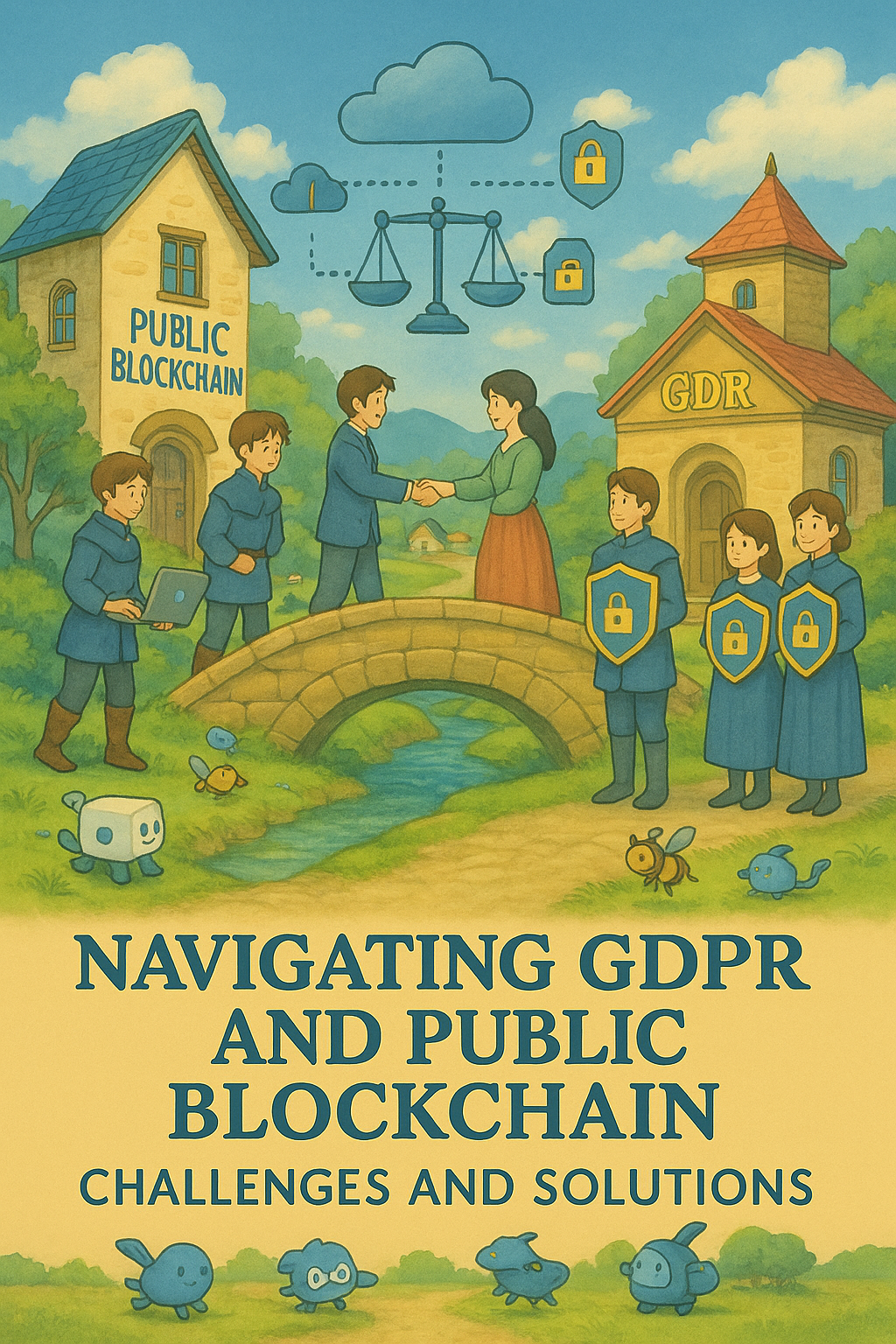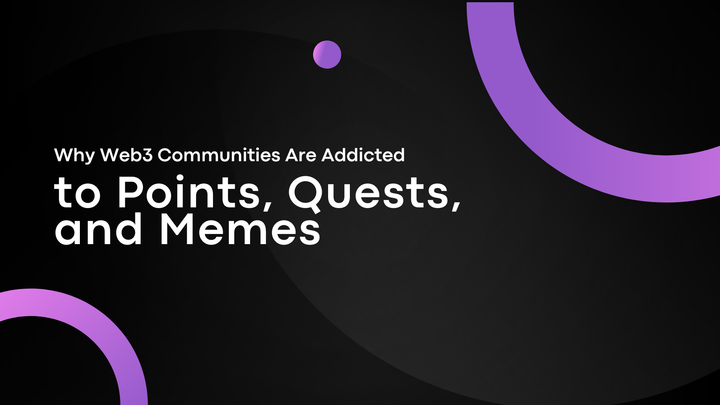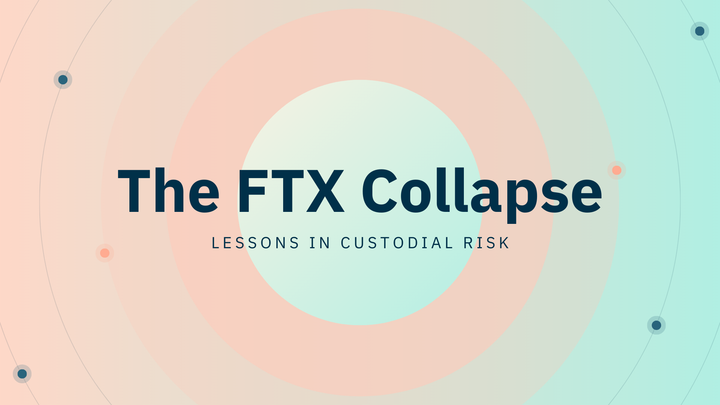Navigating GDPR and Public Blockchain: Challenges and Solutions

Introduction
The General Data Protection Regulation (GDPR) and public blockchains follow very different approaches. GDPR focuses on protecting personal data through user control, data minimization, and accountability. In contrast, public blockchains rely on transparency, immutability, and decentralization features that power innovations in finance, supply chains, and identity systems but often clash with GDPR rules. This article breaks down the key insights from Navigating the Confluence: GDPR Principles and Public Blockchain Characteristics, looking at where these two systems conflict and how they can be brought closer together. It explores technical solutions like off-chain storage and Privacy-Enhancing Technologies (PETs), along with practical strategies for organizations. Real-world examples—such as in healthcare and voting—show how GDPR-compliant blockchain systems can work in practice.
Background: GDPR Principles vs. Blockchain Characteristics
GDPR Core Principles
GDPR’s seven principles govern personal data processing:
- Lawfulness, Fairness, and Transparency: Requires a valid legal basis (e.g., consent, contract) and clear communication to data subjects.
- Purpose Limitation: Data must be collected for specific purposes, with further processing needing compatibility or new consent.
- Data Minimization: Only necessary data should be collected.
- Accuracy: Data must be accurate and rectifiable.
- Storage Limitation: Data should not be retained longer than necessary.
- Integrity and Confidentiality: Data must be secured against unauthorized access.
- Accountability: Controllers must demonstrate compliance via Data Protection Impact Assessments (DPIAs) and Data Protection Officers (DPOs).
These principles assume centralized systems with identifiable controllers, clashing with public blockchains’ decentralized design (ICO).
Public Blockchain Characteristics
Public (permissionless) blockchains have distinct features:
- Immutability: Data, once recorded, is nearly unalterable, ensuring integrity but conflicting with erasure and rectification rights.
- Transparency: Data is visible to all participants, challenging confidentiality and minimization.
- Decentralization: No single entity controls the network, complicating controller identification.
- Pseudonymity: Users are identified by cryptographic addresses, which may be personal data if linkable to individuals (TRM Labs).
- Permissionless Access: Anyone can join, view, or validate transactions, hindering access control.
These traits create direct conflicts with GDPR, particularly immutability versus erasure and transparency versus confidentiality (Debut Infotech).
Permissioned vs. Public Blockchains
The European Data Protection Board (EDPB) prefers permissioned blockchains for GDPR compliance due to their restricted access and defined governance. Unlike public blockchains, permissioned systems limit participation to authorized nodes, simplifying controller identification and data control. For example, a banking consortium could use a permissioned blockchain to share customer data securely, storing sensitive information off-chain to enable erasure and rectification while leveraging blockchain for auditability. Public blockchains require robust mitigations, making them less suitable for personal data unless justified by compelling use cases (Slaughter and May).
Key Conflicts and Mitigation Strategies
The document maps GDPR principles to blockchain characteristics, detailing conflicts and solutions. Below is a summary table, followed by detailed discussions with examples.
Summary of GDPR-Blockchain Mitigations
| GDPR Principle | Blockchain Conflict | Nature of Conflict | Primary Mitigation |
|---|---|---|---|
| Lawfulness, Fairness, Transparency | Decentralization, Transparency | Difficulty establishing legal basis; complex for data subjects to understand processing | Off-chain storage, clear privacy notices, DPIAs |
| Purpose Limitation | Transparency, Immutability | Data accessible for unintended purposes; immutability prevents stopping misuse | Off-chain storage, ZKPs, defined processing purposes |
| Data Minimization | Transparency, Immutability | Stores excess transaction data; transparency exposes data | Off-chain storage, ZKPs, anonymized on-chain data |
| Accuracy/Rectification | Immutability | Cannot correct on-chain data | Off-chain storage, corrective transactions, chameleon hashes |
| Erasure | Immutability | Cannot delete on-chain data | Off-chain storage, cryptographic erasure, redactable blockchains |
| Accountability | Decentralization | Unclear controller identification | Define controllers, DPIAs, appoint DPOs |
- Lawfulness, Fairness, and Transparency:
- Conflict: Decentralization and pseudonymity hinder controller identification and clear processing information. Consent is problematic due to immutability.
- Mitigations:
- Technical: Store personal data off-chain, linking to on-chain hashes; use user-friendly interfaces for transparency. Example: A blockchain identity platform shows privacy notices in layers through a web portal.
- Organizational: Define controllers, conduct DPIAs, provide accessible privacy notices (ICO) (Journal of Cybersecurity).
- Purpose Limitation:
- Conflict: Transparent, immutable data can be accessed for unintended purposes by new participants.
- Mitigations:
- Technical: Use off-chain storage and ZKPs to verify data without exposure. Example: A supply chain blockchain verifies product origins with ZKPs, keeping supplier details off-chain (TRM Labs).
- Organizational: Define processing purposes and implement governance to prevent misuse.
- Data Minimization:
- Conflict: Blockchains store transaction histories, potentially including excess data, visible to all.
- Mitigations:
- Technical: Store minimal data on-chain, using off-chain databases and ZKPs. Example: A voting system uses ZKPs to confirm eligibility without storing voter identities on-chain.
- Organizational: Design systems to collect only essential data (Ailance).
- Accuracy and Right to Rectification:
- Conflict: Immutability prevents direct correction of on-chain data.
- Mitigations:
- Technical: Store data off-chain; append corrective transactions or use chameleon hashes. Example: An academic credential blockchain corrects off-chain records, appending new hashes.
- Organizational: Enable users to report inaccuracies.
- Right to Erasure:
- Conflict: Immutability precludes deletion of on-chain data.
- Mitigations:
- Technical: Use off-chain storage; delete off-chain data to break on-chain links; explore cryptographic erasure or redactable blockchains. Example: A social platform stores user profiles off-chain, deleting them to comply with erasure requests.
- Organizational: Inform users about immutability (Data Protection Commission).
Technical Innovations for Compliance
Off-Chain Storage with On-Chain Anchoring
Storing personal data in mutable off-chain databases, with only cryptographic hashes on-chain, enables erasure and rectification while leveraging blockchain for integrity. For example, a healthcare system stores patient records off-chain, using on-chain hashes to verify data integrity without exposing sensitive information.
Privacy-Enhancing Technologies (PETs)
Balancing privacy with blockchain performance is critical (Dakota Digital Review).
- Zero-Knowledge Proofs (ZKPs): Like proving you’re over 21 without showing your ID, ZKPs verify attributes (e.g., age) without revealing data, supporting data minimization.
- Homomorphic Encryption: Enables computation on encrypted data, though computationally intensive.
- Multi-Party Computation (MPC): Facilitates private collaborative analysis.
- Chameleon Hashes and Redactable Blockchains: Allow controlled data modification, addressing immutability, though GDPR compliance is debated.
Organizational Measures
- DPIAs: Assess risks and mitigation effectiveness.
- Controller Identification: Establish legal entities or consortia for accountability.
- Data Protection by Design: Embed privacy from the outset, favoring permissioned blockchains (Aphaia).
Addressing Data Subject Rights
GDPR’s data subject rights are challenging to implement on public blockchains due to immutability and transparency.
- Right to Erasure (Art. 17 GDPR):
- Conflict: Immutability prevents deletion.
- Mitigations: Store data off-chain, deleting it to break on-chain links. Cryptographic erasure is debated due to key recovery risks. Redactable blockchains are immature. Example: A decentralized social platform stores profiles off-chain, allowing deletion while maintaining on-chain hashes (Redactable).
- Right to Rectification (Art.16 GDPR):
- Conflict: Immutability prevents correction.
- Mitigations: Update off-chain data; append corrective transactions. Example: A blockchain-based academic credential system corrects off-chain records, linking new hashes on-chain.
- Other Data Subject Rights:
- Right of Access (Art. 15 GDPR): Data subjects can request confirmation of data processing and access to their data. In a blockchain context, controllers must link pseudonymous on-chain data (e.g., wallet addresses) to off-chain identities, requiring secure identity verification processes. For example, a decentralized finance platform could provide a dashboard for users to view their transaction history after KYC verification (Andronic and Partners).
- Right to Data Portability (Art. 20 GDPR): Data must be provided in a machine-readable format. This is complex for blockchain data, as on-chain pseudonymous records must be mapped to off-chain personal data. A mitigation could involve exporting off-chain data linked to on-chain hashes in JSON format.
- Right to Object (Art. 21 GDPR): Ceasing processing upon objection is challenging for immutable smart contracts. Mitigation includes designing contracts with pause functionalities or relying on off-chain processing that can be halted. For instance, a marketing blockchain could allow users to opt out by updating an off-chain consent database.
Applications
- Healthcare: A blockchain platform for medical records stores sensitive patient data off-chain in a mutable database, with cryptographic hashes on a public blockchain to verify data integrity. This allows hospitals to comply with GDPR’s erasure and rectification rights by updating or deleting off-chain records while maintaining auditability.
- Voting Systems: Using ZKPs, a decentralized voting platform verifies voter eligibility (e.g., age, residency) without storing personal data on-chain, aligning with data minimization and confidentiality principles (iCert Global).
Notes on Ambiguities
The are several uncertainties in cryptographic erasure, where destroying encryption keys is proposed but debated due to recovery risks. Redactable blockchains and chameleon hashes are promising but lack mature implementations for public blockchains, requiring further research (Redactable).
Conclusion
Reconciling GDPR with public blockchains requires a case-by-case approach, prioritizing off-chain storage, PETs, and robust governance. By using blockchains as integrity layers and embedding data protection by design, organizations can balance innovation and compliance (European Parliament).
Future Directions
Advancements may bridge GDPR-blockchain gaps. Redactable blockchains could resolve immutability conflicts, though governance challenges remain. Efficient homomorphic encryption may enable practical on-chain processing. Updated EDPB guidelines or EU policies could clarify decentralized controller roles (Aphaia). Emerging privacy frameworks, like decentralized identity systems, may further align blockchains with GDPR (Arxiv).
Similar Articles
The Ethics of Immutability: "Code is Law" and Its Consequences
🔒 Smart Contracts: Redefining Trust Through Code
From Anarchy to Autonomy: Reimagining Society Through Blockchain and Web3
References
- Journal of Cybersecurity, Reconciling Blockchain Technology and Data Protection Laws, 2025, https://academic.oup.com/cybersecurity/article/11/1/tyaf002/8024082.
- Dakota Digital Review, Balancing Privacy & Performance, 2025, https://dda.ndus.edu/ddreview/balancing-privacy-performance/.
- Aphaia, EDPB Guidelines on Blockchain and GDPR Compliance, 2025, https://aphaia.co.uk/edpb-guidelines-on-blockchain-and-gdpr-compliance-key-considerations-for-data-controllers/.
- Ailance, Blockchain and GDPR: EDPB Publishes New Guidelines, 2025, https://2b-advice.com/en/2025/04/30/blockchain-and-dsgvo-edsa-publishes-new-guidelines/.
- Slaughter and May, When Decentralisation Meets Regulation: How Blockchain and GDPR Can Coexist, 2025, https://www.slaughterandmay.com/insights/new-insights/when-decentralisation-meets-regulation-how-blockchain-and-gdpr-can-coexist/.
- ICO, A Guide to the Data Protection Principles, 2025, https://ico.org.uk/for-organisations/uk-gdpr-guidance-and-resources/data-protection-principles/a-guide-to-the-data-protection-principles/.
- Data Protection Commission, Quick Guide to the Principles of Data Protection, 2019, https://www.dataprotection.ie/sites/default/files/uploads/2019-11/Guidance%20on%20the%20Principles%20of%20Data%20Protection_Oct19.pdf.
- Debut Infotech, What is Public Blockchain and How Does it Work?, 2025, https://www.debutinfotech.com/blog/what-is-public-blockchain.
- Debut Infotech, Exploring Blockchain with Zero Knowledge Proof Uses, 2025, https://www.debutinfotech.com/blog/zero-knowledge-proof-uses.
- Chainport, What's Fully Homomorphic Encryption (FHE) & How Does it Work, 2025, https://blog.chainport.io/fully-homomorphic-encryption-fhe.
- Partisia, Multi-Party Computation (MPC): A Complete Guide 2025, 2025, https://www.partisia.com/tech/multi-party-computation/.
- Data Protection Commission, Your Rights under the GDPR, 2025, http://www.dataprotection.ie/en/individuals/rights-individuals-under-general-data-protection-regulation.
- Andronic and Partners, The European Data Protection Board Releases Guidance on GDPR Compliance for Blockchain Technologies, 2025, https://www.andronicandpartners.ro/news/the-european-data-protection-board-releases-guidance-on-gdpr-compliance-for-blockchain-technologies.
- iCert Global, Zero Knowledge Proofs (ZKP) in Blockchain: Privacy & Security, 2025, https://www.icertglobal.com/zero-knowledge-proofs-zkp-in-blockchain-blog/detail.
- ResearchGate, Integrating Homomorphic Encryption with Blockchain Technology for Machine Learning Applications, 2025, https://www.researchgate.net/publication/387740806_Integrating_Homomorphic_Encryption_with_Blockchain_Technology_for_Machine_Learning_Applications.
- Cyfrin, Multi-Party Computation (MPC): Secure, Private Collaboration, 2025, https://www.cyfrin.io/blog/multi-party-computation-secure-private-collaboration.
- Redactable, GDPR Redaction Guidelines: Disclose Information Safely, 2025, https://www.redactable.com/blog/gdpr-redaction-guidelines.
- Google Patents, Redactable Blockchain, 2025, https://patents.google.com/patent/US12041160B2/en.
- Gibson Dunn, Europe | Data Protection - April 2025, 2025, https://www.gibsondunn.com/gibson-dunn-europe-data-protection-april-2025/.
- European Parliament, Blockchain and the General Data Protection Regulation, 2025, https://www.europarl.europa.eu/RegData/etudes/STUD/2019/634445/EPRS_STU(2019)634445_EN.pdf.
- Arxiv, A Survey of Blockchain-Based Privacy Applications: An Analysis of Consent Management and Self-Sovereign Identity Approaches, 2025, https://arxiv.org/html/2411.16404v1. Note: User-added source, not in document’s “Works cited.
- TRM Labs, Privacy Coins Glossary, 2025, https://www.trmlabs.com/glossary/privacy-coins. Note: User-added source, not in document’s “Works cited.



Comments ()